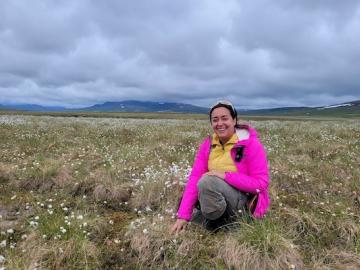Filter News
Area of Research
- (-) Biology and Environment (44)
- (-) Fusion and Fission (7)
- Advanced Manufacturing (1)
- Chemistry and Physics at Interfaces (1)
- Clean Energy (78)
- Data (1)
- Energy Frontier Research Centers (1)
- Functional Materials for Energy (1)
- Isotope Development and Production (1)
- Isotopes (9)
- Materials (34)
- Materials Synthesis from Atoms to Systems (1)
- Materials Under Extremes (1)
- National Security (16)
- Neutron Science (8)
- Nuclear Science and Technology (5)
- Renewable Energy (1)
- Sensors and Controls (1)
- Supercomputing (9)
News Type
News Topics
- Big Data (1)
- Bioenergy (10)
- Biology (17)
- Biomedical (5)
- Biotechnology (2)
- Chemical Sciences (3)
- Clean Water (4)
- Climate Change (6)
- Composites (1)
- Computer Science (2)
- Coronavirus (2)
- Decarbonization (4)
- Energy Storage (1)
- Environment (23)
- Exascale Computing (1)
- Fusion (3)
- High-Performance Computing (5)
- Hydropower (2)
- Isotopes (1)
- ITER (1)
- Machine Learning (1)
- Materials (1)
- Materials Science (2)
- Mathematics (2)
- Mercury (3)
- Microscopy (4)
- Net Zero (1)
- Nuclear Energy (4)
- Physics (2)
- Polymers (1)
- Simulation (3)
- Summit (1)
- Sustainable Energy (6)
- Transportation (1)
Media Contacts

Hydrologist Jesús “Chucho” Gomez-Velez is in the right place at the right time with the right tools and colleagues to explain how the smallest processes within river corridors can have a tremendous impact on large-scale ecosystems.

Erica Prates has found a way to help speed the pursuit of healthier ecosystems by linking the function of the smallest molecules to their effects on large-scale processes, leveraging a combination of science, math and computing.

John “Jack” Cahill is out to illuminate previously unseen processes with new technology, advancing our understanding of how chemicals interact to influence complex systems whether it’s in the human body or in the world beneath our feet.

Matthew Craig grew up eagerly exploring the forest patches and knee-high waterfalls just beyond his backyard in central Illinois’ corn belt. Today, that natural curiosity and the expertise he’s cultivated in biogeochemistry and ecology are focused on how carbon cycles in and out of soils, a process that can have tremendous impact on the Earth’s climate.

Tomás Rush began studying the mysteries of fungi in fifth grade and spent his college intern days tromping through forests, swamps and agricultural lands searching for signs of fungal plant pathogens causing disease on host plants.

With wildfires increasing in scope and intensity around the world, Fernanda Santos’ research into how such calamities affect soil carbon storage has taken on new urgency.

Oak Ridge National Laboratory physicist Elizabeth “Libby” Johnson (1921-1996), one of the world’s first nuclear reactor operators, standardized the field of criticality safety with peers from ORNL and Los Alamos National Laboratory.

Chemical and environmental engineer Samarthya Bhagia is focused on achieving carbon neutrality and a circular economy by designing new plant-based materials for a range of applications from energy storage devices and sensors to environmentally friendly bioplastics.

Science has taken Melanie Mayes from Tennessee to the tropics, studying some of the most important ecosystems in the world.

Friederike (Rike) Bostelmann, who began her career in Germany, chose to come to ORNL to become part of the Lab’s efforts to shape the future of nuclear energy.




